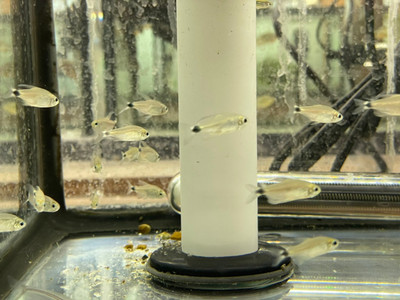Reed Tetra
Posted by Max Gandara on on 2nd Apr 2025
Reed Tetra: A Vibrant Addition to Your Aquarium
Aquarium enthusiasts are always on the lookout for unique and vibrant fish to add to their collections. One such gem is the Reed Tetra, known for its striking colors and lively behavior. In this blog, we'll dive into everything you need to know about this fascinating species, from their origins to caring for them in your home aquarium.
Origins and Natural Habitat
The Reed Tetra, scientifically known as Hyphessobrycon elachys, hails from the river basins of South America, primarily found in countries such as Paraguay and Brazil. These small freshwater fish inhabit slow-moving waters with dense vegetation, which provides them with plenty of cover and food sources. Their natural habitat plays a crucial role in understanding how to replicate similar conditions in a home aquarium.
Physical Characteristics
Reed Tetras are celebrated for their stunning appearance. They possess a translucent body with a shimmering silver hue, complemented by a vibrant red stripe running along their lateral line. This striking coloration makes them a standout addition to any tank. Typically, they grow to about 1.5 inches (3.8 cm) in length, making them ideal for small to medium-sized aquariums.
Tank Setup and Environment
Creating a suitable environment for Reed Tetras is crucial for their well-being:
-
Tank Size: A minimum of 20 gallons is recommended to provide ample space for swimming and social interaction.
-
Water Conditions: Maintain a temperature between 72°F and 79°F (22°C - 26°C) with a pH level of 6.0 to 7.5. Soft, slightly acidic water mimics their natural habitat.
-
Aquascaping: Include plenty of plants and hiding spots. Driftwood and rocks can also be used to replicate the Tetra's natural environment.
-
Lighting: Moderate lighting is preferred, as it enhances their colors without causing stress.
Diet and Feeding
Reed Tetras are omnivorous and have a varied diet in the wild. In captivity, they thrive on a mix of high-quality flake foods, small pellets, and occasional live or frozen foods such as brine shrimp and daphnia. Feeding them a balanced diet will ensure their vibrant colors and overall health.
Behavior and Tank Mates
These fish are known for their peaceful nature, making them excellent community tank residents. Reed Tetras are schooling fish, so it's best to keep them in groups of at least six to encourage natural behavior and reduce stress. They get along well with other small, non-aggressive species like Corydoras, Rasboras, and other Tetras.
Breeding Reed Tetras
Breeding Reed Tetras in captivity can be a rewarding experience. To encourage spawning, it is essential to provide a separate breeding tank with slightly warmer water and plenty of plants for the females to deposit their eggs. Once the eggs are laid, remove the adults to prevent them from eating the eggs. Within a few days, the eggs will hatch, and the fry can be fed infusoria or other suitable fry foods.
Conclusion
Reed Tetras are a vibrant and lively addition to any aquarium, providing beauty and activity with their shimmering colors and social nature. By understanding their needs and replicating their natural habitat, you can enjoy the company of these delightful fish for years to come. Whether you're a seasoned aquarist or a beginner, the Reed Tetra is sure to captivate you with its charm and grace.

